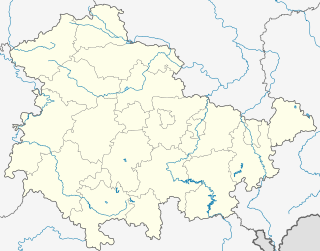Altensteiner cave
| Altensteiner cave
|
||
|---|---|---|
|
Entrance area |
||
| Location: | Thuringian Forest , Germany | |
|
Geographic location: |
50 ° 49 '43 " N , 10 ° 20' 47" E | |
|
|
||
| Type: | Rock and active brook cave | |
| Discovery: | 1799 | |
| Show cave since: | 1802 | |
| Lighting: | electric | |
| Overall length: | about 2000 meters | |
| Length of the show cave area: |
280 meters | |
| Website: | official page | |
The Altensteiner Höhle is located below the Altensteiner Park in the Schweina district of the city of Bad Liebenstein in Thuringia . It is considered to be the longest cave in Thuringia. It was discovered in 1799 when the road to Altenstein Castle was being built and expanded into the oldest show cave in Thuringia by spring 1802. The public entrance to the cave is below the road from Schweina to Altenstein Castle.
Emergence
The Altensteiner Höhle is a secondary cave created by chemical weathering ( karst ) . The framework rock forms an approximately 255 million year old reef limestone of the Upper Permian ( Zechstein ).
The cave is where fossils from the Ice Age were found. Among other things, bones of cave bears ( Ursus spelaeus ) were found which, according to more recent studies (Braniek, 2002), date from the Early to Middle Vistula Glacial Period, ie are 40,000-100,000 years old. In the scientific collection of the University of Jena there are not only teeth from cave bears but also ten parts of a chain made from mussel shells, which were dated as Neolithic finds .
Exploration and development
The development of the cave as a show cave was arranged by Duke Georg I of Saxony-Meiningen as part of the design of the Altensteiner Park. The development and design of the cave was carried out, in keeping with the zeitgeist of the time, in the romantic style ; Among other things, the backdrop of a temple ("Papierner Tempel") was installed on the underground cave lake in 1802, but was demolished again in 1869. The first paleontological examination of the cave took place in 1801, Ernst Friedrich von Schlotheim continued the exploration of the cave in 1813, 1816 and 1820.
In 1909 the cave received electric lighting. In the Second World War it served as an air raid shelter. The use as a show cave and further exploration of the cave was resumed from 1951. The cave was re-measured and plans for an exit tunnel were made. Work on this was canceled in the early 1960s due to collapses in the overburden.
Increased research activity from the year 2000 onwards has allowed us to research a corridor length of around 2000 meters, and rooms with numerous stalactites have also been discovered. Other names of cave sections are bear cave , upper gallery , temple , lake view and rainbow hall .
The length of the guideway is about 330 meters. A tour takes about 45 minutes. The regular concerts and theater performances in the cathedral , one of the largest rooms in the show cave, are a particular magnet for visitors .
The Academy for Geosciences and Geotechnologies awarded the Altensteiner Reef Complex and the Altensteiner Cave the title of " National Geotope " in September 2019 .
Cave waters
The Altensteiner Höhle is an active river cave. The cave stream carries an average of around 100 liters of water per second. After long periods of drought, the amount of water can drop to below 40 l / s, but it can also rise to over 300 l / s during snowmelt or after heavy rainfall.
Protection status
The Altensteiner Höhle has been part of the National GeoPark Thuringia Inselsberg - Drei Gleichen since 2006 . As part of Altensteiner Park, it is a listed building . It was designated as a natural monument as early as the 1940s . The cave is an important winter home for the lesser horseshoe bat .
See also
swell
- Gunter Braniek: The finds of remains of the cave bear ('Ursus spelaeus' Rosenmüller 1794) from the caves of Altenstein and Bad Liebenstein. In: Series of publications by the Thuringian State Institute for Environment and Geology. 2002, No. 55, pp. 101-134, TLUG (Hrsg.): The Altenstein cave in Schweina - natural and cultural history of a geotope.
- Fritz Kühnemund: Sensational find from the Altensteiner cave . In: Altensteiner Blätter . tape 1999/2000 . Bauer and Malch, Immelborn, S. 24-27 (n.d. [2001]).
Web links
- Altensteiner Höhle , private website
- The "Altensteiner Höhle" near Schweina, geotope description of the Thuringian State Institute for Environment and Geology (TLUG)
- Altensteiner Höhle (PDF), geoscientific geotope description of the Thuringian State Institute for Environment and Geology (TLUG)
Individual evidence
- ↑ Altenstein ist Nationaler Geotop , insuedthueringen.de, accessed on September 24, 2019


